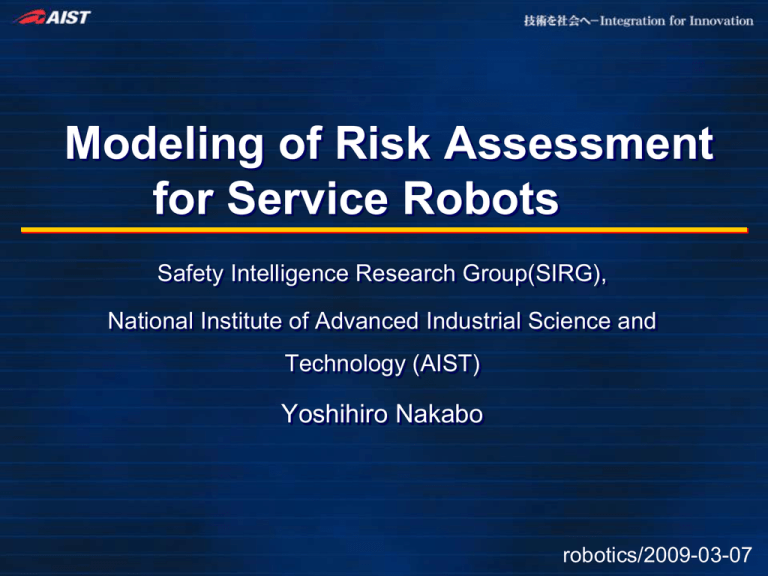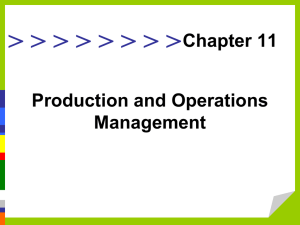Yoshihiro Nakabo, AIST
advertisement

Modeling of Risk Assessment for Service Robots Safety Intelligence Research Group(SIRG), National Institute of Advanced Industrial Science and Technology (AIST) Yoshihiro Nakabo robotics/2009-03-07 Contents • Objective: Safe Robots • International safety standards (ISO/IEC) • Proposal – Object oriented approach to robot safety – Models for risk identification – Model for overall risk assessment • Conclusion 2 Next generation service robots • For Business: Cleaning, Welfare, Security, Guidance • Home: House keeping, Hobby, Security • Service robot = close proximity with human -> Safety issue should be clarified 3 Next generation industrial robots • Power assisting robot: already used in some motor companies • Next generation cell production robots 4 Safety of next generation robots • Socially accepted safety technology required (unless almost zero risk for unknown new products) • Previously: – Industrial robots -> separation of human and robots – Service robots -> no fundamental principles • Recently: – ―Collaborative operation‖ included in International Standard for safety of industrial robots (ISO10218) – New ISO standardization in progress for service robots – ―Safety guidelines for next-generation robots‖ in Japan 5 Int. Standards for Safety of Machinery ISO/IEC Guide 51 determines hierarchical structure type-A standards (basic safety standards) ISO12100・・・Safety of machinery — Basic concepts, general principles for design — ISO14121・・・Safety of machinery — Risk assessment — type-B standards (generic safety standards) ISO13849・・System safety IEC61508・・Functional safety ISO13855・・Safety distances IEC61496・・Safety sensors type-C standards (machine safety standards) Machine tools, Chemical plants, Electric lifts Industrial robots, Earth-moving machinery, Press machine 6 ISO12100 Safety of Machinery • Safety: freedom from unacceptable risk • Risk: combination of the probability of the occurrence of harm and the severity of that harm • Harm: physical injury or damage to the health of people, or property or the environment from ISO12100 7 ISO12100 Safety of Machinery • Communication with users from ISO12100 8 ISO 14121 Risk Assessment • Risk assessment: Systematic analysis and evaluation of the risks associated with machinery. • Should be executed by safety assessors, robot designers and engineers • Details are explained latter… 9 IEC 61508 Functional Safety • The V Model: software safety integrity and the development lifecycle from IEC61508-3 10 Example of recommended technologies • Depends on SIL(Safety Integrity Level) • Validation for safety requirements R: Recommended HR: Highly recommended • Example: from IEC61508-3 11 Problems • Many individual processes and large amount of documentation • Frequent communication between users, designers and safety assessors • Waterfall instead of Agile • Could be solved by modeling and CAD related tool assistance 12 Proposal • Object Oriented modeling for robot safety – Definitions of safety, risk and other terms – Include processes for risk assessment, risk reduction and evaluation – Construct framework through UML profiling • Accelerate development of safe service robots • Change process from waterfall to agile 13 Risk reduction process Risk assessment Is residue risk acceptable? Concepts for safety of machinery: Yes • No zero risk • Start from risk assessment (determining requirements) • Three step risk reduction • Judge residue risk • Safeguards = Functional safety No Risk reduction Step 1. Intrinsic safety Step 2. Safe guard Step 3. Information for use 14 Risk assessment process Determination of the limits of the machinery Risk analysis Hazard identification Risk assessment Risk estimation Risk evaluation Is residue risk acceptable? Yes No Risk reduction 15 Limits of machinery Consideration of necessary phases and tasks Extraction of those concerned with each phase or task Operation manual Detailed design document Consideration of definition of object operation Use case diagram Study the structural model of machine Study operation scenario Class diagram of machine Create scenario (activity diagram) for each use case Activity diagram 16 Example of hazards • Example of hazards listed in ISO 14121 • Any combination of origin and potential consequences should be considered • Hazards classified by group type 17 Example of typical hazards • Subset of the hazard table 18 from ISO14121 Class diagram • UML diagram can be used for modeling ISO hazard description (includes humans and environment as elements of risk) 19 Example of hazardous situations Listed life cycle: • Transport • Assembly and installation, Commissioning • Setup, Teaching/programming and/or process changeover • Operation • Cleaning, Maintenance • Fault finding/Troubleshooting • Decommissioning, Dismantling • All phases of machine life cycle should be taken into account • Each phase consists of separate tasks 20 Hazard Identification Hazard identification by: • Extracting risks from activity diagrams and class diagram of object machine • Considering potential consequences and origin of hazards Process to be continued until all risks indentified 21 Rest of Processes in Risk Assessment • Risk estimation (quantitative analysis) – Severity of harm – Probability of occurrence • Exposure of person to the hazards • Occurrence of hazardous events • Possibility of avoiding or limiting the harm • Risk evaluation (if the risk has been adequately reduced) • Documentation 22 UML model of risk assessment Lifecycle Documents Risk assessment process Use case diagram Origin of hazards Machinery (Class diagram) Tasks Hazardous parts of machinery Hazardous situations in tasks Severity Activity diagram Risk assessment data Exposure Occurrence Possibility of avoidance Actor Potential consequence Risk estimation basis Red class :Listed in ISO 14121 Yellow class :UML diagrams Green class :Outside scope of presentation 23 Conclusion • Proposed an object oriented modeling of ISO based risk assessment • All processes and safety related concepts can be modeled by using UML models • Standardization of proposed UML should be useful for the propagation of known safety principles, development of CAD-based risk assessment and design of safety related robot modules • Future work will be focused on developing UML profile, implementing risk estimation and evaluation 24



